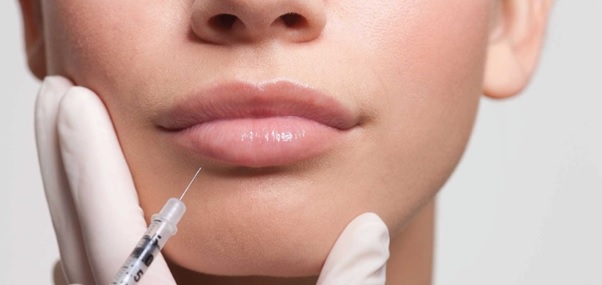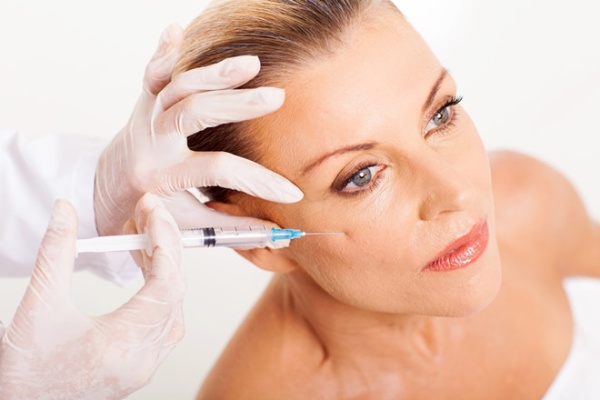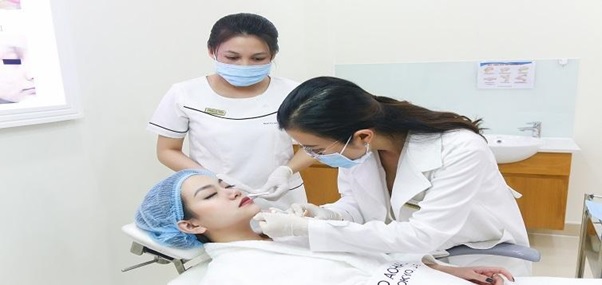- ROHTO AOHAL CLINIC: RECRUITMENT NEWS FEBRUARY 2024 22.02.2024
- 10+ SURPRISINGLY WAY OF MELASMA TREATMENT AND LIMIT RECURRENCE 13.03.2024
- The difference between Botox and Fillers 05.05.2021
- The secret to skin tightening that women should not skip 28.08.2023
- How safe are Botox injections for the jawline? 28.06.2021
DERMATOLOGISTS GUIDE EFFECTIVE HYPERPIGMENTATION TREATMENTS
|
Table of Contents 1. What is hyperpigmentation? Skin pigmentation depends on what factors? 2. Causes of hyperpigmentation in the skin 3. Dermatologists guide the treatment of hyperpigmentation
|
Hyperpigmentation is a fairly common skin problem, is not a disease and is usually harmless. With hyperpigmentation, patches of skin will become darker than normal skin. However, this condition causes loss of aesthetics and lack of confidence for the sufferer. Currently, there are many methods to treat hyperpigmentation, but the most effective and safe method will be suggested by experts below.
1. What is hyperpigmentation? Skin pigmentation depends on what factors?
Pigment is the component that determines the color of each person's skin, hair and eyes. Pigmentation is caused by the deposition of melanin produced by melanocytes, or melanocytes. Most people have about the same amount of melanocytes.
The difference in human skin color on continents is due to the amount of melanin produced and is not affected by sunlight. Besides, skin color also depends on melanin pigments, which form a natural protective barrier for the skin against UV rays.
Melanin pigment is divided into 2 types:
- Eumelanin: This is the best known type of melanin pigment. Eumelanin is black or dark brown, often found in people with brown or black skin. This melanin pigment helps protect the skin from UV rays.
- Pheomelanin: This type of melanin pigment is also known as red melanin. Pheomelanin is commonly found in white people or people with red hair. This type of melanin has no effect against UV rays and the synthesis of this type of melanin can also produce free radicals.
Two types of melanin are present in everyone. However, each person has a different ratio of each type of melanin. The amount of these two types of pigments will determine the natural skin color, as well as the degree of darkening of the skin when exposed to sunlight.
Hyperpigmentation is a condition in which small dark patches or spots appear on the skin or cover large areas of skin that are different from the color of the surrounding skin. This phenomenon often occurs when the skin has excess melanin - a brown pigment that forms deposits on the skin. Hyperpigmentation can occur on any skin color of any continent or race. This change in skin color is usually harmless, but it can be a warning sign of another health condition.
Some common skin hyperpigmentation conditions are:
- Freckles
- Melasma
- Sun spots
- Post-inflammatory skin hyperpigmentation
2. Causes of hyperpigmentation in the skin
The causes of increased skin pigmentation are very diverse, coming from both the impact of the external environment and internal factors such as hormones and age.
- Impact from UV rays of sunlight
Sunlight is the leading cause of skin hyperpigmentation. In sunlight, UV rays will activate the skin's ability to produce melanin pigment.
Melanin acts as the skin's natural "sunscreen", creating a film that absorbs and protects the skin from harmful UV rays. That's why skin often turns red when exposed to sunlight. Too much sun exposure can enhance this process, leading to hyperpigmentation.
- Hormonal changes
Hormonal changes are the main cause of a particular type of hyperpigmentation, called melasma or chloasma. Melasma is very common in women and occurs when female hormones including estrogen and progesterone stimulate excessive melanin production. In addition, hyperpigmentation can also be a side effect of some hormonal treatments.
- Due to aging
When entering the aging process, the number of melanocytes in the epidermal melanocytes decreases, but the remaining cells increase in size and the distribution becomes more concentrated. These physiological changes are the cause of the appearance and increase of age spots in people over 40 years old.
- Skin after injury or inflammation
Post-inflammatory hyperpigmentation occurs after the skin is damaged or inflamed due to causes such as scratches, skin burns, skin exposure to chemicals, acne, atopic dermatitis, and psoriasis. The skin darkens after the wound heals.
- Impact of disease and medication
Hyperpigmented skin can also be a symptom of a number of diseases such as metabolic disorders, vitamin deficiencies, and autoimmunity. Hyperpigmentation can also form due to the effects of certain drugs such as antibiotics, chemotherapy drugs, antimalarial drugs, and anticonvulsants.
3. Dermatologists guide the treatment of hyperpigmentation
3.1. How to treat hyperpigmentation at home is simple and easy to do
There are some simple and natural ways to treat hyperpigmentation at home below:
- Mix lemon juice with yogurt or honey, apply directly to the skin for 10 minutes, then rinse with water.
- Squeeze juice from aloe vera leaves and apply directly to darkened skin twice a day to see clear results.
- Apply apple cider vinegar directly to the dark spots and leave for 20 minutes, then rinse with cold water.
- Use a yogurt mask to apply on your face for 20 minutes, then rinse with warm water.
- Combine turmeric powder with yogurt to make a skin-brightening mask.
- Squeeze the berry juice onto a clean cloth and apply it to your face for 15 minutes, then rinse the mixture with warm water.
3.2. Treatment of hyperpigmentation using cosmetic techniques
- Microdermabrasion
Microdermabrasion is a cosmetic method of treating hyperpigmentation. This method affects the skin's epidermis. With this method, the doctor will use a handheld deviceOf Gentle and fast on the skin to remove brown spots. This method often requires many treatment sessions to get the desired results. Microdermabrasion is effective in treating mild hyperpigmentation and is suitable for people with light skin.
- Skin abrasion
Dermabrasion also removes the epidermis, but also partially affects the dermis. This means it is deeper than microdermabrasion.
Dermabrasion uses a hand-held device similar to microdermabrasion. This device isOf quickly on the skin to remove dark spots on the epidermis and the top part of the dermis.
This is a solution for people who want to radically improve skin hyperpigmentation. Suitable for both white and dark skin people, hyperpigmentation patches usually fade after 8 weeks of treatment
3.3. Modern technologies treat hyperpigmentation thoroughly
- BBL Light
BBL pulsed light is a world-famous hyperpigmentation treatment technology developed by Sciton company (USA) and certified by the FDA for safety and effectiveness.
BBL broad-spectrum pulsed light technology mainly affects the epidermis (outermost layer) of the skin. BBL light beams gently break down the structure of pigment molecules into microscopic molecules. Finally, they are eliminated according to the body's natural mechanism.
- Laser Q-Switched
Q-Switched laser is a widely used and leading technology in treating forms of skin hyperpigmentation such as dark spots, freckles, age spots...
Q-Switched Laser technology was invented by two famous brands in the field of cosmetic treatment: Medlite and Lutronic. The Q-Switched lasers of these two brands are both approved by the FDA for safety.
Q-Switched laser has the ability to penetrate deep into the skin, affecting both the epidermis and dermis. This type of laser has 2 wavelengths: 562 nm (affecting the epidermis) and 1,064 nm (affecting the dermis).
To treat hyperpigmentation, doctors often use 562 nm wavelength. The Q-Switched Laser will gently break down pigment molecules that cause dark spots into extremely small supermolecules and let the body eliminate them on its own.
- Phi kim SYLFIRM
When the SYLFIRM needle enters the skin, the needle body will radiate RF (Radio Frequency) energy. The energy emitted from the tip of the needle will enter the skin, then pulse back up along the body of the needle, creating a selective effect in the shape of a teardrop. This mechanism allows SYLFIRM nonmetals to precisely target damaged skin cells without affecting neighboring healthy skin areas. In addition, the reverse pulse effect will help control heat better, avoiding excessive heat entering the skin and causing burns.
SYLFIRM nonmetal emits energy at a frequency of 2mHz, reaching a maximum depth of 3.5mm below the skin. The needle body stays in the skin precisely within 0.32 seconds, just enough for treatment and does not cause burns or dark skin after treatment. With a selective action mechanism, SYLFIRM radio non-metallic provides effective energy pulses to regenerate the basement membrane (which supports melanin pigment cells), helping to completely resolve the condition of melanin hyperpigmentation, limiting Melanin goes deeper into the skin, making it difficult to treat. A strong basement membrane helps treat hyperpigmentation many times faster and more effectively.
The ideal treatment for hyperpigmentation is to combine SYLFIRM nonmetal therapy with BBL/Laser light technology. BBL/Laser light will resolve superficial pigmentation on the skin surface, while SYLFIRM non-metallic helps restore the basement membrane, repairing damaged skin cells. From there, hyperpigmentation will be completely treated, stabilized and unlikely to return.
Rohto Aohal Clinic is currently the pioneer in owning the above three famous hyperpigmentation treatment technologies, highly appreciated for their effectiveness by customers around the world. Hyperpigmentation treatments at Rohto Aohal Clinic all use technology that has been certified by the US FDA as safe and suitable for the skin.
In addition, Rohto Aohal Clinic's team of doctors are trained directly from American experts on how to use the above hyperpigmentation treatment technologies. It can be said that Rohto Aohal Clinic is confident with the title "Leading dark pigmentation treatment unit in Vietnam".
4. Secret to protecting skin to prevent hyperpigmentation
- Always apply sunscreen with an SPF index of 30+, carefully shield your skin before going out to prevent the impact of UV rays, and slow down the process of melanin proliferation.
- Be careful when using cosmetics, only use those that are suitable for your skin, have a clear origin and ingredient list.
- Consider taking medications that have the risk of increasing melanin pigmentation. After using the medicine, if you see melanin hyperpigmentation on your skin, you should stop using the medicine and consult a doctor.
- Limit stress, prolonged stress will stimulate the production of melanin pigment. Keep your mind at ease, avoid overworking, staying up late, etc. Set up some rest and relaxation habits for yourself such as reading books, listening to music, walking, yoga, meditation, etc.
Above are the hyperpigmentation treatment methods suggested by experts. To be examined and consulted on effective skin hyperpigmentation treatment, don't hesitate to contact Rohto Aohal Clinic today.
ROHTO AOHAL CLINIC - CONTACT INFORMATION
1st location: 02 Pham Dinh Toai, Vo Thi Sau ward, District 3, Ho Chi Minh City
☎ Phone: (028) 3930 9555
2nd location: 207/4 Nguyen Van Thu, Da Kao Ward, District 1, Ho Chi Minh City
☎ Phone: (028) 3827 9737
3rd location: 136 Trieu Viet Vuong, Nguyen Du Ward, Hai Ba Trung District, Ha Noi City
☎ Phone: (024) 3375 5588







